«Excursion to the medieval city Kutna Hora»
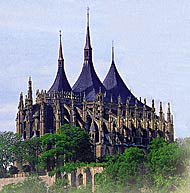 There
are cities that retain their glory throughout the ages: such is the
medieval town of Kutna Hora, due east of Prague. As legend has it, one
day in the 13th century a monk from Sedlec monastery was out collecting
firewood in the forest, when he stumbled upon some silver nuggets. Laying
down his robe as a marker, he hurried home to tell his fellow monks
about his fortuitous discovery. The ensuing “silver fever”
transformed the city of Kutna Hora into the silver capital of the Middle
Ages. During our tour, we’ll go into the depths of an ancient
silver mine, and visit the courtyard where Italian silversmiths minted
the famous “Prague penny”. We’ll travel down the road
a bit to the Sedlec Ossuary for a taste of the truly grotesque. Lovers
of the macabre will gape in appreciation at the chapel’s interior:
the altar and all its appointments, including a massive chandelier,
have been fashioned from over 40 thousand human bones, skulls and all.
In addition, we will visit one of Europe’s most beautiful and
awe-inspiring Gothic cathedrals, dedicated to Saint Barbara, the patroness
of miners.
There
are cities that retain their glory throughout the ages: such is the
medieval town of Kutna Hora, due east of Prague. As legend has it, one
day in the 13th century a monk from Sedlec monastery was out collecting
firewood in the forest, when he stumbled upon some silver nuggets. Laying
down his robe as a marker, he hurried home to tell his fellow monks
about his fortuitous discovery. The ensuing “silver fever”
transformed the city of Kutna Hora into the silver capital of the Middle
Ages. During our tour, we’ll go into the depths of an ancient
silver mine, and visit the courtyard where Italian silversmiths minted
the famous “Prague penny”. We’ll travel down the road
a bit to the Sedlec Ossuary for a taste of the truly grotesque. Lovers
of the macabre will gape in appreciation at the chapel’s interior:
the altar and all its appointments, including a massive chandelier,
have been fashioned from over 40 thousand human bones, skulls and all.
In addition, we will visit one of Europe’s most beautiful and
awe-inspiring Gothic cathedrals, dedicated to Saint Barbara, the patroness
of miners.
![]() Individual English speaking guide (5 hours) — 60 euros
Individual English speaking guide (5 hours) — 60 euros
Admission fees (not included / optional):
![]() Kutna
Hora (St. Barbara cathedral, Sedlec ossuary, medieval silver mines) —
8 euros / person
Kutna
Hora (St. Barbara cathedral, Sedlec ossuary, medieval silver mines) —
8 euros / person
![]() Car transfer — 60 euros
Car transfer — 60 euros
![]() Train ticket — 7 euros / person (your guide's ticket is in additional charge for the group)
Train ticket — 7 euros / person (your guide's ticket is in additional charge for the group)
«Excursion to the hunting castle Krivoklat»
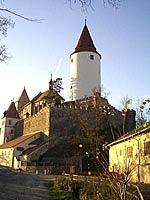 Krivoklat,
the oldest hunting castle of Czech kings, dates from the 11th century
Premyslid dynasty. It is easily one of the most intriguing Gothic castles
in Central Europe, situated west of Prague on the rocky crags of the
Beroun River. The future Emperor of the Holy Roman Empire, Charles IV,
whiled away his childhood years here. In the 16th century, Krivoklat
held some of the royal treasury and, oddly, at the same time also served
as a prison for some of Bohemia’s most heinous criminals and disgraced
aristocrats. The notorious 16th century charlatan, Edward Kelley, spent
time here. He had attempted to swindle the Emperor Rudolf II into believing
he had uncovered the secret of the philosopher stone, and got caught
out. Krivoklat’s many impressive offerings include fully-equipped
torture chambers; outstanding interiors such as the vast 13th century
Gothic reception hall, the Silver Room, the Knights Hall; a late Gothic
collection of paintings and sculptures; and the Royal Library with more
than 53,000 manuscripts and books.
Krivoklat,
the oldest hunting castle of Czech kings, dates from the 11th century
Premyslid dynasty. It is easily one of the most intriguing Gothic castles
in Central Europe, situated west of Prague on the rocky crags of the
Beroun River. The future Emperor of the Holy Roman Empire, Charles IV,
whiled away his childhood years here. In the 16th century, Krivoklat
held some of the royal treasury and, oddly, at the same time also served
as a prison for some of Bohemia’s most heinous criminals and disgraced
aristocrats. The notorious 16th century charlatan, Edward Kelley, spent
time here. He had attempted to swindle the Emperor Rudolf II into believing
he had uncovered the secret of the philosopher stone, and got caught
out. Krivoklat’s many impressive offerings include fully-equipped
torture chambers; outstanding interiors such as the vast 13th century
Gothic reception hall, the Silver Room, the Knights Hall; a late Gothic
collection of paintings and sculptures; and the Royal Library with more
than 53,000 manuscripts and books.
![]() Individual
English speaking guide (5 hours) — 60 euros
Individual
English speaking guide (5 hours) — 60 euros
Admission fees (not included / optional):
![]() Castle
Krivoklat — 8 euros / person
Castle
Krivoklat — 8 euros / person
![]() Car
transfer — 60 euros
Car
transfer — 60 euros
![]() Train
ticket — 8 euros / person (your guide's ticket is in additional
charge for the group)
Train
ticket — 8 euros / person (your guide's ticket is in additional
charge for the group)
«Excursion to the royal castle Karlštejn»
 In
1355, the Czech king, Charles IV, was enthroned as Emperor of the Holy
Roman Empire. His coronation was a seminal event in the history of the
Czech Lands, and forever changed the destiny of Prague. Under the dictates
of Charles IV, the provincial city was transformed into the resplendent
capitol of Europe, and held the title for the next quarter century.
Yet, despite Prague’s rise in stature, the Emperor thought it
unwise to store the empire’s vast treasure trove within its confines.
Summoning the realm’s most-acclaimed architect, Matthias of Arras,
Charles had him design the majestic Karlstejn to house the empire’s
riches. The citadel’s forbidding site, with its lofty and secluded
air, soon became a mirror of its owner – the reclusive Emperor
practically abandoned Prague for the private world of Karlstejn. Renovations
have restored its regal, inviolate atmosphere, and today Karlstejn remains,
as it has for centuries, the Empire’s treasure chest, as well
as a storehouse for priceless Christians relics, Czech royal regalia
and the state archives.
In
1355, the Czech king, Charles IV, was enthroned as Emperor of the Holy
Roman Empire. His coronation was a seminal event in the history of the
Czech Lands, and forever changed the destiny of Prague. Under the dictates
of Charles IV, the provincial city was transformed into the resplendent
capitol of Europe, and held the title for the next quarter century.
Yet, despite Prague’s rise in stature, the Emperor thought it
unwise to store the empire’s vast treasure trove within its confines.
Summoning the realm’s most-acclaimed architect, Matthias of Arras,
Charles had him design the majestic Karlstejn to house the empire’s
riches. The citadel’s forbidding site, with its lofty and secluded
air, soon became a mirror of its owner – the reclusive Emperor
practically abandoned Prague for the private world of Karlstejn. Renovations
have restored its regal, inviolate atmosphere, and today Karlstejn remains,
as it has for centuries, the Empire’s treasure chest, as well
as a storehouse for priceless Christians relics, Czech royal regalia
and the state archives.
![]() Individual
English speaking guide (5 hours) — 60 euros
Individual
English speaking guide (5 hours) — 60 euros
Admission fees (not included / optional):
![]() Castle
Karlštejn — 9 euros / person
Castle
Karlštejn — 9 euros / person
![]() Car
transfer — 60 euros
Car
transfer — 60 euros
![]() Train
ticket — 7 euros / person (your guide's ticket is in additional
charge for the group)
Train
ticket — 7 euros / person (your guide's ticket is in additional
charge for the group)
«Excursion to the Castle of Archduke Ferdinand d'Este - Konopište»
 One
of the most sensational and history-laden Gothic castles in the Czech
Republic, Konopište was the residence of Archduke Franz Ferdinand
d’Este, whose assassination at Sarajevo in 1914 touched off the
First World War. The archduke’s mania was hunting, and the castle’s
decorative interiors and corridors were designed to show off his immense
collection of hunting trophies and unique weaponry. Many of the exhibits,
such as “Shooting Gallery with Moving Targets”, are downright
bizarre. Surrounding the castle is a magnificent, sprawling park with
a gorgeous rose garden. Strolling through its peaceful grounds, one
often encounters peacocks stepping regally about the fine sculptures,
fountains and ponds.
One
of the most sensational and history-laden Gothic castles in the Czech
Republic, Konopište was the residence of Archduke Franz Ferdinand
d’Este, whose assassination at Sarajevo in 1914 touched off the
First World War. The archduke’s mania was hunting, and the castle’s
decorative interiors and corridors were designed to show off his immense
collection of hunting trophies and unique weaponry. Many of the exhibits,
such as “Shooting Gallery with Moving Targets”, are downright
bizarre. Surrounding the castle is a magnificent, sprawling park with
a gorgeous rose garden. Strolling through its peaceful grounds, one
often encounters peacocks stepping regally about the fine sculptures,
fountains and ponds.
![]() Individual
English speaking guide (5 hours) — 60 euros
Individual
English speaking guide (5 hours) — 60 euros
Admission fees (not included / optional):
![]() Castle
Konopište — 7 euros / person
Castle
Konopište — 7 euros / person
![]() Car
transfer — 60 euros
Car
transfer — 60 euros
![]() Train
ticket — 8 euros / person (your guide's ticket is in additional
charge for the group)
Train
ticket — 8 euros / person (your guide's ticket is in additional
charge for the group)
«Excursion to Cesky Krumlov»
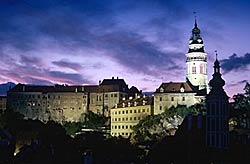 In
South Bohemia, at a serpentine bend in the Vltava River, lies the quaint
town of Cesky Krumlov. Its original medieval owners, the powerful Rozmberk
called it the "City of the Red Rose" after their family crest.
Later the city became the property of the Schwarzenberg aristocracy.
The huge castle dominates the town’s center, looming over red-tile
roofs and the labyrinthine, cobble-stoned streets. The castle offers
a wealth of architectural details and 15th century treasures. Picture-postcard
houses crowd the hills and the banks of the river that snakes through
the heart of the city. Through a courtyard, we find the museum dedicated
to Cesky Krumlov’s most famous homeboy, the early 20th century
painter, Egon Schiele. In a medieval cellar tavern the servers dress
in period costumes. The Germans called the town “Krumme Aue”
or “the crooked meadow” – following the twists and
turns of its little streets and stone bridges, we understand why. The
undulating curves of the Vltava only serve to enhance the city’s
appeal. And the curves don’t stop at the river. If it appears
to your eye that many of the houses have distinctly odd outlines, well,
they do! Medieval builders, who were blissfully unaware of the existence
of right angles, constructed many of them.
In
South Bohemia, at a serpentine bend in the Vltava River, lies the quaint
town of Cesky Krumlov. Its original medieval owners, the powerful Rozmberk
called it the "City of the Red Rose" after their family crest.
Later the city became the property of the Schwarzenberg aristocracy.
The huge castle dominates the town’s center, looming over red-tile
roofs and the labyrinthine, cobble-stoned streets. The castle offers
a wealth of architectural details and 15th century treasures. Picture-postcard
houses crowd the hills and the banks of the river that snakes through
the heart of the city. Through a courtyard, we find the museum dedicated
to Cesky Krumlov’s most famous homeboy, the early 20th century
painter, Egon Schiele. In a medieval cellar tavern the servers dress
in period costumes. The Germans called the town “Krumme Aue”
or “the crooked meadow” – following the twists and
turns of its little streets and stone bridges, we understand why. The
undulating curves of the Vltava only serve to enhance the city’s
appeal. And the curves don’t stop at the river. If it appears
to your eye that many of the houses have distinctly odd outlines, well,
they do! Medieval builders, who were blissfully unaware of the existence
of right angles, constructed many of them.
![]() Individual
English speaking guide (10 hours) — 90 euros
Individual
English speaking guide (10 hours) — 90 euros
Admission fees (not included / optional):
![]() Castle
Ceský Krumlov — 7 euros / person
Castle
Ceský Krumlov — 7 euros / person
![]() Car
transfer — 90 euros
Car
transfer — 90 euros
«Excursion - Karlovy Vary, Krušovice Brewery, castle Loket»
Krušovice
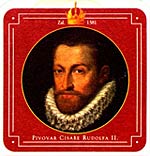 On
the way to Karlový Vary and Loket, we will stop off at the city
famed for its world-class Krušovice beer, brewed here since 1581.
Be forewarned: in 1583, when the Emperor Rudolph II stopped in Krušovice
to taste the unique flavor of the brew, he ended up buying the brewery
for the Royal Crown. Here, in the heart of the Krušny Mountains,
amidst the pure spring waters and sweet scented hops of the fields surrounding
Krušovice, you will experience what goes into making this fabled
brew. Mother Nature and the skills of famed brewers combine to create
this unique liquid gold. Our tour ends with a sampling of Krušovice’s
three varieties of beer: dark, light and light ležak. Moreover,
as at any taste testing, no one will limit your consumption!
On
the way to Karlový Vary and Loket, we will stop off at the city
famed for its world-class Krušovice beer, brewed here since 1581.
Be forewarned: in 1583, when the Emperor Rudolph II stopped in Krušovice
to taste the unique flavor of the brew, he ended up buying the brewery
for the Royal Crown. Here, in the heart of the Krušny Mountains,
amidst the pure spring waters and sweet scented hops of the fields surrounding
Krušovice, you will experience what goes into making this fabled
brew. Mother Nature and the skills of famed brewers combine to create
this unique liquid gold. Our tour ends with a sampling of Krušovice’s
three varieties of beer: dark, light and light ležak. Moreover,
as at any taste testing, no one will limit your consumption!
Karlovy Vary
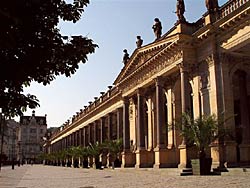 In
1358, while out on an Imperial Hunt, Emperor Charles IV spied one of
the deer mortally wounded by his party fall at a small spring in the
woods. As he rode towards it, the deer roused, lapped at the spring
waters and, to his amazement, leapt up and bounded away. The inexplicable
curative powers of the spring so impressed the Emperor that he ordered
his court architects to build a hunting lodge at its source. This is
the legend behind the founding of the spa city, Karlovy Vary, and its
city symbol is taken from the little deer “that got away”
that day 600 years ago. Since then Karlovy Vary has been known as the
cosmopolitan European spa with renowned curative energies – Goethe
and Beethoven, as well as a few emperors, took “the cure”
here. This graceful, ancient spa, surrounded by forested hills, with
a rich history and Belle Epoch architecture, has long been considered
one of Europe’s most beautiful cities. A wonderful walking tour
around the city center awaits you in Karlovy Vary, where you will have
the opportunity to visit the Moser Glass Factory with its famed souvenirs
from local porcelain craftsmen.
In
1358, while out on an Imperial Hunt, Emperor Charles IV spied one of
the deer mortally wounded by his party fall at a small spring in the
woods. As he rode towards it, the deer roused, lapped at the spring
waters and, to his amazement, leapt up and bounded away. The inexplicable
curative powers of the spring so impressed the Emperor that he ordered
his court architects to build a hunting lodge at its source. This is
the legend behind the founding of the spa city, Karlovy Vary, and its
city symbol is taken from the little deer “that got away”
that day 600 years ago. Since then Karlovy Vary has been known as the
cosmopolitan European spa with renowned curative energies – Goethe
and Beethoven, as well as a few emperors, took “the cure”
here. This graceful, ancient spa, surrounded by forested hills, with
a rich history and Belle Epoch architecture, has long been considered
one of Europe’s most beautiful cities. A wonderful walking tour
around the city center awaits you in Karlovy Vary, where you will have
the opportunity to visit the Moser Glass Factory with its famed souvenirs
from local porcelain craftsmen.
Loket
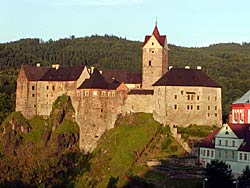 The
town of Loket sprang up around its unassailable fortress, founded during
the Middle Ages on the very borders of the Czech lands by the Premyslids,
the first Czech dynasty. Its hoary past speaks of glory and ruin - the
vagaries of history. Wandering through this dreamy town, we pass through
over a thousand years of history as we travel from the powerful walls
of the old fortress to the fairytale Baroque houses rimming its market
square.
The
town of Loket sprang up around its unassailable fortress, founded during
the Middle Ages on the very borders of the Czech lands by the Premyslids,
the first Czech dynasty. Its hoary past speaks of glory and ruin - the
vagaries of history. Wandering through this dreamy town, we pass through
over a thousand years of history as we travel from the powerful walls
of the old fortress to the fairytale Baroque houses rimming its market
square.
![]() Individual
English speaking guide (10 hours) — 90 euros
Individual
English speaking guide (10 hours) — 90 euros
Entrées (non comprises / sur demande):
![]() Moser
Glass Factory — 4 euros / person
Moser
Glass Factory — 4 euros / person
![]() Krušovice Brewery — 6 euros / person
Krušovice Brewery — 6 euros / person
![]() Castle
Loket — 5 euros / person
Castle
Loket — 5 euros / person
![]() Car
transfer — 100 euros
Car
transfer — 100 euros
«Excursion to the castle Cesky Sternberg»
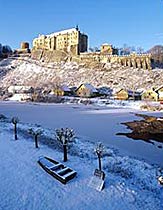 Since
the hoary days of the 13th century, the ancient Sternberg aristocracy
has held title to this massive Gothic castle overlooking the Sazava
River. Down through the ages family ancestors have included brave knights,
the royally titled, diplomats, scientists, politicians, and a sprinkling
of philosophers and historians. During the Communist years, the castle
was confiscated by the state and fell into ruin; the elder Sternberg
was forced to work as a museum caretaker in his former home. After the
1989 Velvet Revolution, the ancient complex was returned to its former
owners and was gradually restored. Today Sternberg boasts a permanent
exhibition relating the family’s centuries-old history, an art
collection and sumptuous displays of antique porcelains and period furniture.
And again, an heir to the Sternberg dynasty lives and works in the home
of his ancestors – only this time, willingly.
Since
the hoary days of the 13th century, the ancient Sternberg aristocracy
has held title to this massive Gothic castle overlooking the Sazava
River. Down through the ages family ancestors have included brave knights,
the royally titled, diplomats, scientists, politicians, and a sprinkling
of philosophers and historians. During the Communist years, the castle
was confiscated by the state and fell into ruin; the elder Sternberg
was forced to work as a museum caretaker in his former home. After the
1989 Velvet Revolution, the ancient complex was returned to its former
owners and was gradually restored. Today Sternberg boasts a permanent
exhibition relating the family’s centuries-old history, an art
collection and sumptuous displays of antique porcelains and period furniture.
And again, an heir to the Sternberg dynasty lives and works in the home
of his ancestors – only this time, willingly.
![]() Individual
English speaking guide (5 hours) — 60 euros
Individual
English speaking guide (5 hours) — 60 euros
Admission fees (not included / optional):
![]() Castle
Ceský Sternberg — 5 euros / person
Castle
Ceský Sternberg — 5 euros / person
![]() Car
transfer — 60 euros
Car
transfer — 60 euros
«The Wine cellars of Melnik»
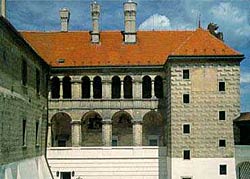 Situated
north of Prague on the Labe River, the small town of Melnik has a history
going back over a thousand years, and holds a unique place in Czech
history. Originally the site was a possession of Bohemia’s earliest
queen, Ludmila, and for many centuries afterwards, it served as a refuge
for widowed queens and princesses. Vineyards first appeared in the 14th
century. Today the area’s unique climate and the traditional techniques
employed by local wine-makers produce the high-quality wines for which
Melnik is justly famous.
Situated
north of Prague on the Labe River, the small town of Melnik has a history
going back over a thousand years, and holds a unique place in Czech
history. Originally the site was a possession of Bohemia’s earliest
queen, Ludmila, and for many centuries afterwards, it served as a refuge
for widowed queens and princesses. Vineyards first appeared in the 14th
century. Today the area’s unique climate and the traditional techniques
employed by local wine-makers produce the high-quality wines for which
Melnik is justly famous.
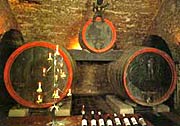 In 1753 Ludmila’s castle passed into the possession of the ancient
Lobkovitz family.The family’s 18th century renovations –
and the much-needed restoration carried out by the Lobkovitz heir after
the fall of Communism – produced the gorgeous Renaissance chateau
visitors see today. Its interiors show off a priceless art collection,
and its extensive wine cellars boast an impressive wine archive. We
will visit the cellars and sample the splendid local wines.
In 1753 Ludmila’s castle passed into the possession of the ancient
Lobkovitz family.The family’s 18th century renovations –
and the much-needed restoration carried out by the Lobkovitz heir after
the fall of Communism – produced the gorgeous Renaissance chateau
visitors see today. Its interiors show off a priceless art collection,
and its extensive wine cellars boast an impressive wine archive. We
will visit the cellars and sample the splendid local wines.
![]() Individual
English speaking guide (5 hours) — 60 euros
Individual
English speaking guide (5 hours) — 60 euros
Admission fees (not included / optional):
![]() Castle
Melnik — 5 euros / person
Castle
Melnik — 5 euros / person
![]() Wine tasting (2 sorts) — 4 euros / person
Wine tasting (2 sorts) — 4 euros / person
![]() Wine
tasting (6 sorts) — 7 euros / person
Wine
tasting (6 sorts) — 7 euros / person
![]() Car
transfer — 60 euros
Car
transfer — 60 euros
«The Terezin Fortress»
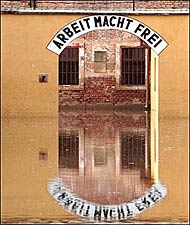 Fortress
Terezin was built in the 18th century to serve as the northern fortifications
of the Habsburg Empire. It lives on in Czech memory, not for the glorious
battles fought there, but as a terrible reminder of the Nazi Occupation.
Terezin served as a round-up site for Jewish citizens throughout the
country and the rest of Nazi-occupied Europe. Here the people lived
in the Ghetto until they were transported east to the Death Camps –
or perished. During the Nazi Occupation, 140,000 Jewish people were
deported to Terezin, tens of thousands died here from starvation, overcrowding
and brutal treatment; there were only 17,500 survivors at war’s
end. The Ghetto Museum, established in 1991, suffered some damage from
the fierce floods of 2002, but has since been repaired. It presents
an extensive exhibition of historical documents, oral histories, films
and photographs which enable the visitor to witness the terrible suffering
of those who lived and died there.
Fortress
Terezin was built in the 18th century to serve as the northern fortifications
of the Habsburg Empire. It lives on in Czech memory, not for the glorious
battles fought there, but as a terrible reminder of the Nazi Occupation.
Terezin served as a round-up site for Jewish citizens throughout the
country and the rest of Nazi-occupied Europe. Here the people lived
in the Ghetto until they were transported east to the Death Camps –
or perished. During the Nazi Occupation, 140,000 Jewish people were
deported to Terezin, tens of thousands died here from starvation, overcrowding
and brutal treatment; there were only 17,500 survivors at war’s
end. The Ghetto Museum, established in 1991, suffered some damage from
the fierce floods of 2002, but has since been repaired. It presents
an extensive exhibition of historical documents, oral histories, films
and photographs which enable the visitor to witness the terrible suffering
of those who lived and died there.
![]() Individual
English speaking guide (5 hours) — 60 euros
Individual
English speaking guide (5 hours) — 60 euros
Admission fees (not included / optional):
![]() Terezin
— 6 euros / person
Terezin
— 6 euros / person
![]() Car
transfer — 60 euros
Car
transfer — 60 euros
«Koneprusy Caves»
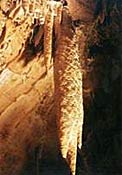 A
fascinating journey awaits you. This outing focuses on the ancient geological
history of the Czech Lands – the 400 million year-old Koneprusy
Cave System. We are off on an exciting adventure to the center of the
earth! The caves have 3 entrance levels; they run 70 meters under the
ground and are over 2 kilometers long. As we follow the paths, we uncover
the secrets of our earth, pause to learn of past archeological finds
and the fossils of the various creatures that have called these caves
home over these millions of years. As we pass through the vaulting cave
chambers, astonishing formations of stalagmites and stalactites greet
our eyes. Their beautiful, otherworldly shapes stir the imagination.
Many of them have been given fanciful names, such as “The Swan"
and "The Body" and the breathtaking "Eternal Aspiration"
– how many can you pick out?
A
fascinating journey awaits you. This outing focuses on the ancient geological
history of the Czech Lands – the 400 million year-old Koneprusy
Cave System. We are off on an exciting adventure to the center of the
earth! The caves have 3 entrance levels; they run 70 meters under the
ground and are over 2 kilometers long. As we follow the paths, we uncover
the secrets of our earth, pause to learn of past archeological finds
and the fossils of the various creatures that have called these caves
home over these millions of years. As we pass through the vaulting cave
chambers, astonishing formations of stalagmites and stalactites greet
our eyes. Their beautiful, otherworldly shapes stir the imagination.
Many of them have been given fanciful names, such as “The Swan"
and "The Body" and the breathtaking "Eternal Aspiration"
– how many can you pick out?
![]() Individual
English speaking guide (5 hours) — 60 euros
Individual
English speaking guide (5 hours) — 60 euros
Admission fees (not included / optional):
![]() Koneprusy caves — 5 euros / person
Koneprusy caves — 5 euros / person
![]() Car
transfer — 60 euros
Car
transfer — 60 euros